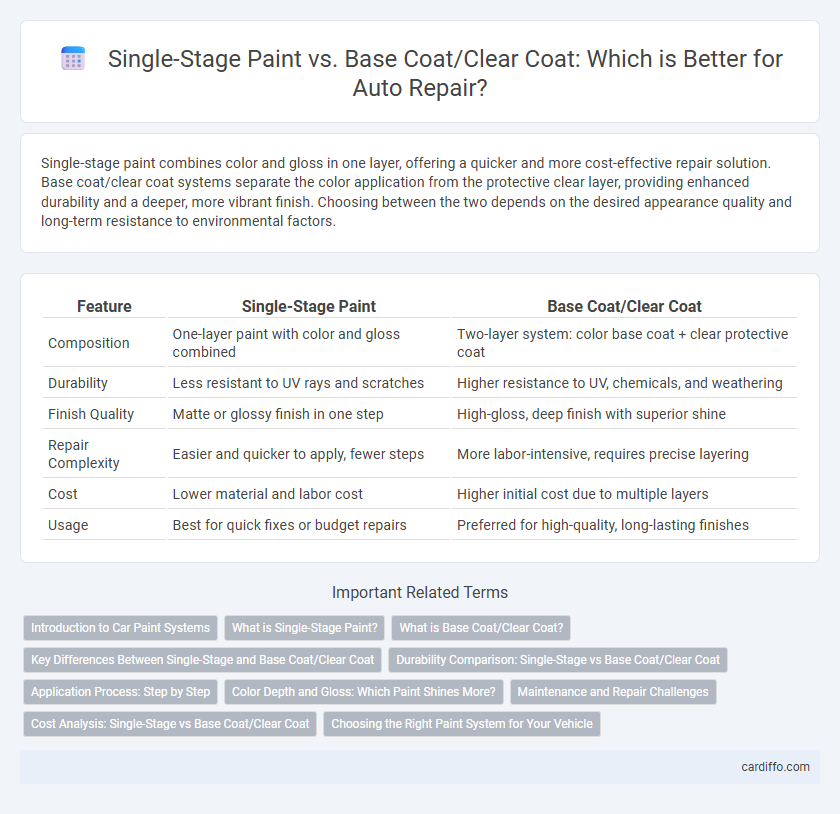Single-stage paint combines color and gloss in one layer, offering a quicker and more cost-effective repair solution. Base coat/clear coat systems separate the color application from the protective clear layer, providing enhanced durability and a deeper, more vibrant finish. Choosing between the two depends on the desired appearance quality and long-term resistance to environmental factors.
Table of Comparison
| Feature | Single-Stage Paint | Base Coat/Clear Coat |
|---|---|---|
| Composition | One-layer paint with color and gloss combined | Two-layer system: color base coat + clear protective coat |
| Durability | Less resistant to UV rays and scratches | Higher resistance to UV, chemicals, and weathering |
| Finish Quality | Matte or glossy finish in one step | High-gloss, deep finish with superior shine |
| Repair Complexity | Easier and quicker to apply, fewer steps | More labor-intensive, requires precise layering |
| Cost | Lower material and labor cost | Higher initial cost due to multiple layers |
| Usage | Best for quick fixes or budget repairs | Preferred for high-quality, long-lasting finishes |
Introduction to Car Paint Systems
Single-stage paint combines color and gloss in one layer, offering a simpler and quicker application process ideal for minor repairs or budget projects. Base coat/clear coat systems separate the color layer from the protective clear coat, providing enhanced durability, UV resistance, and a higher-quality finish preferred in professional auto body repairs. Understanding these car paint systems is essential for choosing the right approach to achieve optimal appearance and longevity in vehicle refinishing.
What is Single-Stage Paint?
Single-stage paint combines color and gloss in one layer, providing a straightforward application process ideal for small repairs and budget projects. It offers durability and a uniform finish without requiring a clear coat, reducing labor time and material costs. Single-stage paint is commonly used in automotive repair shops for quick touch-ups and restoring original factory color.
What is Base Coat/Clear Coat?
Base coat/clear coat is a two-step automotive paint system where the base coat provides color and the clear coat adds a glossy, protective finish. The base coat contains pigments for color depth and is applied first, followed by the clear coat that shields against UV rays, scratches, and environmental damage. This method enhances durability and appearance compared to single-stage paint, which combines color and protection in one layer.
Key Differences Between Single-Stage and Base Coat/Clear Coat
Single-stage paint combines color and gloss in one layer, providing a quicker and more cost-effective repair solution compared to the base coat/clear coat system. Base coat/clear coat offers superior depth, durability, and UV resistance by applying a color layer followed by a transparent protective layer, making it ideal for high-end finishes. Repair shops often prefer base coat/clear coat for its ability to better match factory finishes and resist fading over time.
Durability Comparison: Single-Stage vs Base Coat/Clear Coat
Single-stage paint offers moderate durability with a simpler application process but tends to fade and chip faster over time compared to base coat/clear coat systems. Base coat/clear coat provides enhanced protection due to its clear lacquer layer, which resists UV damage, scratches, and chemicals more effectively. Professional repair shops prefer base coat/clear coat for long-lasting finishes, especially on high-traffic or luxury vehicles, ensuring superior longevity and color retention.
Application Process: Step by Step
The single-stage paint application process involves cleaning, sanding, and applying one uniform coat that combines color and gloss, followed by drying. In contrast, the base coat/clear coat system requires spraying a base color layer first, allowing it to flash dry, then applying multiple clear coat layers to enhance gloss and protection. Precise mixing ratios, flash-off times, and meticulous spray techniques are essential for optimal results in both methods.
Color Depth and Gloss: Which Paint Shines More?
Base coat/clear coat systems provide superior color depth and gloss compared to single-stage paints, creating a richer, more vibrant finish that mimics the natural depth of automotive paint. The clear coat enhances UV protection and adds a glossy layer that increases durability and shine over time. Single-stage paints tend to offer a flatter appearance with less gloss and color intensity, making base coat/clear coat systems the preferred choice for high-quality automotive repairs.
Maintenance and Repair Challenges
Single-stage paint offers easier touch-ups and less complex repairs, as it combines color and gloss in one layer, reducing labor time and cost. Base coat/clear coat systems require more meticulous maintenance, with potential for clear coat peeling and color matching difficulties during repairs. Professionals often prefer base coat/clear coat for superior durability and finish quality despite the increased repair complexity.
Cost Analysis: Single-Stage vs Base Coat/Clear Coat
Single-stage paint offers a lower initial cost due to its simpler application process, reducing labor and material expenses compared to base coat/clear coat systems. Base coat/clear coat involves separate layers, increasing both the time and resources needed, which typically results in higher overall repair costs. The choice between the two should consider the long-term value, as base coat/clear coat provides better durability and finish quality that may offset its higher upfront investment.
Choosing the Right Paint System for Your Vehicle
Single-stage paint combines color and gloss in one layer, offering a cost-effective and quicker application ideal for older or budget vehicles. Base coat/clear coat systems provide superior durability and a high-gloss finish by applying a pigmented base coat followed by a protective clear coat, making them the preferred choice for modern, high-end vehicles. Selecting the right paint system depends on factors like vehicle type, budget, desired finish longevity, and environmental exposure.
Single-stage paint vs Base coat/clear coat Infographic

 cardiffo.com
cardiffo.com